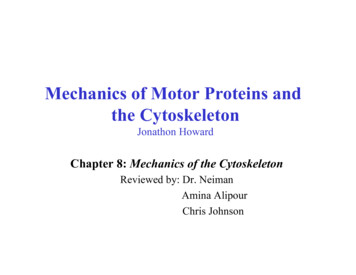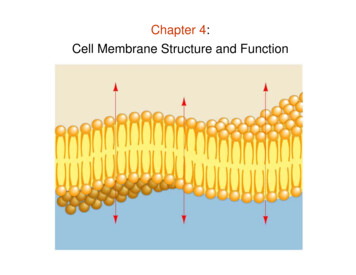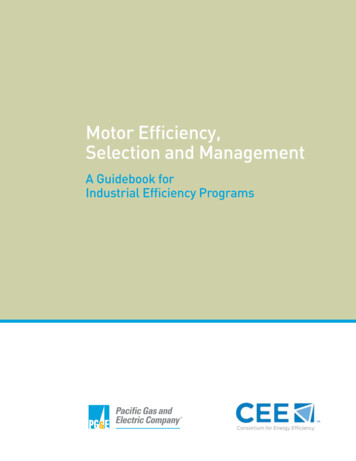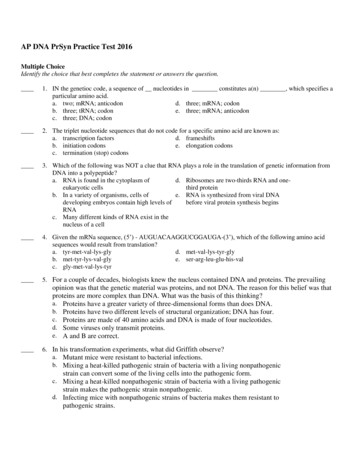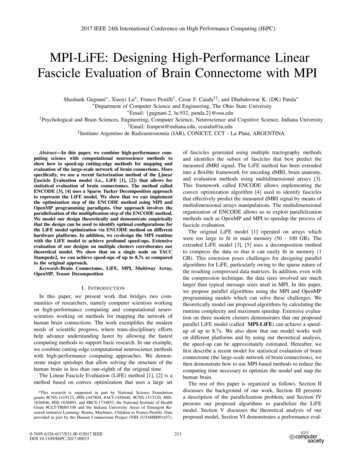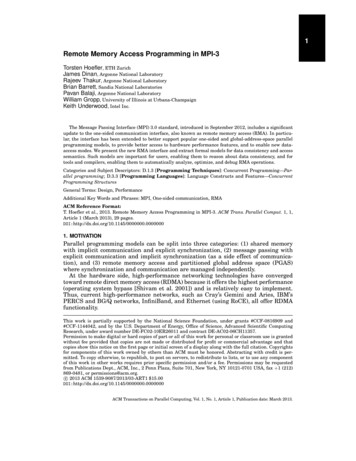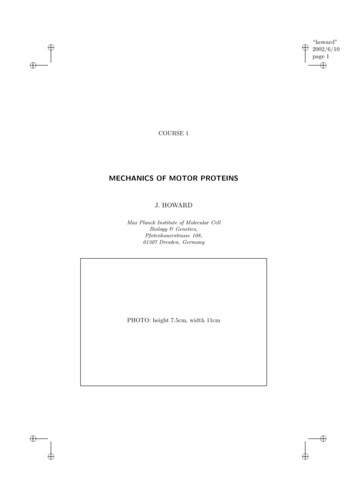
Transcription
iii“howard”2002/6/10page 1iCOURSE 1MECHANICS OF MOTOR PROTEINSJ. HOWARDMax Planck Institute of Molecular CellBiology & Genetics,Pfotenhauerstrasse 108,01307 Dresden, GermanyPHOTO: height 7.5cm, width 11cmiiii
i “howard”i2002/6/10page 2iiContents1 Introduction32 Cell motility and motor proteins43 Motility assays54 Single-molecules assays75 Atomic structures96 Proteins as machines117 Chemical forces128 Effect of force on chemical equilibria139 Effect of force on the rates of chemical reactions1410 Absolute rate theories1711 Role of thermal fluctuations in motor reactions1912 A Mechanochemical model for kinesin2113 Conclusions and outlook23iiii
iii“howard”2002/6/10page 3iMECHANICS OF MOTOR PROTEINSJ. Howard1IntroductionMotor proteins are molecular machines that convert the chemical energyderived from the hydrolysis of ATP into mechanical work used to powercellular motility. In addition to specialized motile cells like muscle fibersand cellular processes like cilia, all eukaryotic cells contain motor proteins(Fig. 1). The reason is that eukaryotic cells are large and their cytosols arecrowded with filaments and organelles; as a result, diffusion is too slow toefficiently move material from one part of a cell to another (Luby-Phelpset al. 1987). Instead, the intracellular transport of organelles such as vesicles, mitochondria, and chromosomes is mediated by motor proteins. Theseproteins include myosins and dyneins that are relatives of the proteins foundin the specialized muscle and ciliated cells, as well as members of a thirdfamily of motor proteins, the kinesins, which are distantly related to themyosin family.The focus of this chapter is on how motor proteins work. How do theymove? How much fuel do they consume, and with what efficiency? How dochemical reactions generate force? What is the role of thermal fluctuations?These questions are especially fascinating because motor proteins are unusual machines that do what no manmade machines do–they convert chemical energy to mechanical energy directly, rather than via an intermediatesuch as heat or electrical energy. Tremendous insight into this chemomechanical energy transduction process has come from technical developmentsover the last ten years that allow single protein molecules to be detectedand manipulated. The goal of this review is to provide a framework withinwhich to understand these new observations: how do mechanical, thermal,and chemical forces converge as a molecular motor moves along its filamentous track. For background, the reader is directed to Molecular Biology ofthe Cell (Alberts et al. 2002) for an introduction to the biology of cells andmolecules, to Cell Movements (Bray 2000) for a broad review of cell motility, and to Mechanics of Motor Proteins and the Cytoplasm (Howard 2001)for more detailed discussion of the mechanics of molecular motors and thecytoskeleton.c EDP Sciences, Springer-Verlag 2002iiii
iii4“howard”2002/6/10page 4iPhysics of Bio-Molecules and CellsFig. 1. Motor proteins and cellular motility.2Cell motility and motor proteinsThe study of motor proteins begins with myosin, which drives the contraction of muscle. Myosin was first isolated as a complex with actin filamentsby Kühne (Kühne et al. 1864), though it was not until the 1940s thatthe complex was dissociated into the separate proteins, myosin and actin(Straub 1941-2; Szent-Gyorgyi 1941-2). The discovery of the myosin crossbridges by H.E. Huxley in 1957 (Huxley 1957b, Fig. 2A) provided a molecular basis for the contraction of muscle: the bending or rotation of thesecrossbridges causes the actin-containing thin filaments to slide relative tothe myosin-containing thick filaments, and the sliding of these filaments, inturn, leads to the shortening of the muscle, as had been demonstrated a fewyears earlier (Huxley & Hanson 1954; Huxley & Niedergerke 1954).Since its initial discovery, the crossbridge (also called a head) has provento be central to the mechanism of cell motility. Dynein, which drives thebeating of cilia, was identified in the 1963 (Gibbons 1963). The dyneincrossbridges cause the adjacent doublet microtubules to slide with respect toeach other (Fig. 2B). Because shear between the microtubules at the base ofthe cilium (e.g. near the head of the sperm) is prevented by strong linkages,the sliding is converted into bending of the microtubules along the lengthof the cilium. In this way the sperm undergoes its snake-like propulsionthrough solution. Kinesin, which moves organelles along microtubules, waspurified in 1985 (Brady 1985; Vale et al. 1985). Attached to the cargoat one end, the crossbridges at the other end of the kinesin molecule walkalong the surface of the microtubule (Fig. 2C).iiii
iiiJ. Howard: Mechanics of Motor Proteins“howard”2002/6/10page 5i5Fig. 2. Crossbridges formed by the motor domains of motor proteins drive motionalong cytoskeletal filaments. A. Muscle. Myosin crossbridges protruding from thethick, myosin-containing filament drive the sliding of the thin, actin-containingfilaments. B. Sperm. Dynein crossbridges cause the sliding of adjacent microtubules. C. Kinesin crossbridges walk along microtubules carrying organelles.In all cases studied in detail, the motion of a motor protein is directed.Actin filaments and microtubules are polar structures made of asymmetric protein subunits, and a given motor always moves towards a particularend of the filament. The myosin, dynein and kinesin families have a largenumber of members. For example, humans have 33 genes which code forproteins of similar amino acid sequence to the heavy chain of muscle p://www.mrc-lmb.cam.ac.uk/myosin/myosin.html), and they have 21 dynein heavy-chaingenes and 45 kinesin genes (Miki et al. 2001; http://www.blocks.fhcrc.org/ kinesin/index.html). Interestingly, different myosins go in differentdirections along actin filaments and different kinesins go in different directions along microtubules. This is important because the orientation of actinfilaments and microtubules in cells is tightly controlled: thus, by using differently directed motors cells are able to move cargoes from one part of thecell to another (and back) in order to organize the cells internal structure.3Motility assaysThe study of motor proteins was revolutionized by the development ofin vitro motility assays in which the motility of purified motor proteinsalong purified cytoskeletal filaments is reconstituted in cell-free conditions.iiii
iii6“howard”2002/6/10page 6iPhysics of Bio-Molecules and CellsFig. 3. A Motility assay in which the motor is bound to a surface and the filamentis observed to glide over the surface in the presence of ATP. B, C. Fluorescentlylabeled microtubules gliding across a kinesin-coated surface (15 s between frames).The arrowed microtubule has a bright mark on its slowly growing end (called theminus end): this end leads, showing that kinesin is a minus-end-directed motor.An important milestone in this development was the visualization of fluorescent beads coated with purified myosin moving along actin cables in thecytoplasm of the alga Nitella (Sheetz & Spudich 1983). This was quicklyfollowed by the first completely reconstituted assay in which motor-coatedbeads were shown to move along oriented filaments made from purified actinthat had been bound to the surface of a microscope slide (Spudich et al.1985). Though “threads” of actin and myosin had been known to contract inthe presence of ATP (Szent-Gyorgyi 1941), this contraction was very slow.The significance of the new findings was that they proved that myosin (together with actin) was sufficient to produce movement at rates consistentwith the speeds of muscle contraction and cell motility.There are two geometries used in in vitro motility assays: the glidingassay and the bead assay. In the gliding assay, the motors themselves arefixed to the substrate, and the filaments are observed under a light microscope as they diffuse down from solution, attach to, and glide along themotor-coated surface (Fig. 3) in the presence of ATP (Fig. 4). In the beadassay, filaments are fixed to a substrate, such as a microscope slide, andiiii
iiiJ. Howard: Mechanics of Motor Proteins“howard”2002/6/10page 7i7Fig. 4. The hydrolysis of the gamma-phosphate bond (arrowed) of ATP can besummarized by the following reaction: ATP ADP Pihi[ATP]eq[ATP]c G G0 kT ln [ADP] G 54 10 21 J0 ln [ADP] [P ][P]c i ceqi eqwhere the subscript c refers to cellular concentrations and the subscript eq refersto equilibrium concentrations. In cells, the reaction is very far from equilibriumwith typical concentrations [ATP] 1 mM, [ADP] 0.01 mM and [Pi] 1 mM;this makes the free energy very large and negative G 100 10 21 J.motors are attached to small plastic or glass beads with typical diametersof 1 µm. The motions can be recorded and the speed measured by trackingthe centroid of the bead or the leading edge of the filament (see Scholey1993 for detailed methods). There is good overall agreement between thespeed of a motor protein in vitro and the speed of the cellular motion thatis attributed to the motor (Table 1).4Single-molecules assaysThe progress of research on motor proteins has gone hand-in-hand withincreases in the sensitivity of light microscope techniques. Single proteinmolecules can now be observed and manipulated. A crucial developmentwas the visualization of individual actin filaments by darkfield microscopy(Nagashima & Asakura 1980). This was followed by visualization of micro-iiii
iii8“howard”2002/6/10page 8iPhysics of Bio-Molecules and CellsTable 1. Motor speeds in vivo and in vitro.MotorSpeeda Speedb ATPasec Functionin vivo in vitro(s 1 )(nm/s) (nm/s)Myosins1. Myosin IB?2006Amoeboid motility, hair cell adaptation2. Myosin II6000800020Fast skeletal muscle contraction3. Myosin II2002501.2Smooth muscle contraction4. Myosin V20035055. Myosin VIND–580.8Vesicle transport?6. Myosin XI60 00060 000NDCytoplasmic streamingVesicle transportDyneins7. Axonemal–7000–450010Sperm and cilial motility8. Cytoplasmic–1100–12502Retrograde axonal transport, mitosis,transport in flagellaKinesins9. Conventional180084044Anterograde axonal transport10. Nkin800180078Transport of secretory vesicles11. Unc104/KIF6901200110Transport of synaptic vesicle precursorsand mitochondria12. Fla10/KinII2000400ND13. BimC/Eg518602Transport in flagella, axons, melanocytesMitosis and meiosis14. NcdND–901Meiosis and mitosistubules by differential interference contrast microscopy (Allen et al. 1981)and actin filaments by fluorescence microscopy (Yanagida et al. 1984). Further refinement of the motility assays led to detection of movement by singlemotor molecules (Howard et al. 1989). With improved fluorescence sensitivity, it was even possible to image individual fluorescently labeled motors(Funatsu et al. 1995) (rather than the much larger filaments), and to watchthe motors individually while they move along filaments (Vale et al. 1996;Yajima et al. 2002). The combination of these assays with increasinglysophisticated optical and mechanical techniques such as optical tweezers(Svoboda et al. 1993) has allowed measurement of the stepwise movementof motors along their filaments (Fig. 5) and the measurement of the forcegenerated by a single motor protein (Fig. 11).Single-molecule mechanical and optical techniques are now being appliedto many biochemical processes mediated by other molecular machines; theseiiii
iiiJ. Howard: Mechanics of Motor Proteins“howard”2002/6/10page 9i9Fig. 5. A rat kinesin molecule taking 8 nm steps along a microtubule at low ATPconcentration. (Courtesy of Nick Carter and Rob Cross).include ATP synthesis (Noji et al. 1997), DNA transcription (Wang et al.1998), DNA replication (Wuite et al. 2000), The folding of individual proteins (Deniz et al. 2000) and RNA (Liphardt et al. 2001) can also befollowed. The techniques can even be used to record from molecules on thesurfaces of intact cells (Sako et al. 2000; Benoit et al. 2000; Schutz et al.2000) and recordings deep inside cells should soon be possible. Thus singlemolecule techniques are becoming to cell biology what the patch clamptechnique and single ion-channel recordings are to neurobiology (Neher &Sakmann 1976; Sakmann & Neher 1995).5Atomic structuresThe structural and physical basis for motility has been placed on a firmfoundation by the solution of the atomic structures of actin (Kabsch et al.1990) and myosin (Rayment et al. 1993) and of tubulin (Lowe and Amos,1998; Nogales et al. 1998) and kinesin (Kull et al. 1996). By fitting theatomic structures into electron micrographs, atomic models of the actinfilament (Holmes et al. 1990) and the microtubule (Nogales et al. 1999)have been built. There are also reasonable guesses for how the motors dockto these filaments (e.g. Fig. 6).iiii
iii10“howard”2002/6/10page 10iPhysics of Bio-Molecules and CellsFig. 6. Kinesin docked to the microtubule. Kinesin has two identical heads joinedby the dimerization domain (dark). Each head binds nucleotide, which was ADPin these crystallization conditions. The microtubule is composed of dimers of theclosely-related α and β tubulins. The dimers associated “head-to-tail” to form apolar structure that has the β-subunit at the plus end.The atomic structures have brought many key questions into focus. Forexample, how do small changes associated with the hydrolysis of ATP (onthe order of a few Angströms) lead to protein conformational changes on theorder of several nanometers? What determines the directionality of a motorprotein? The detailed answers to these problems will require many additional atomic structures: the motors complexed with their filaments, and themotors with different nucleotides bound to them (e.g. ATP, ADP and Pi ,ADP and no nucleotide). But this will be very difficult, and even whensolved, these structures will provide only static pictures, with no kinetic orenergetic information: photographing an internal combustion engine at topdead center and at the bottom of the down stroke does not explain how itworks. In the following sections I will address some of physical and ther-iiii
iiiJ. Howard: Mechanics of Motor Proteins“howard”2002/6/10page 11i11modynamic questions which are essential to answer in order to understandhow conformational changes driven by ATP hydrolysis might generate forceand produce directed motion.6Proteins as machinesThe structural and single-molecule results reinforce the concept of proteinsas machines (Alberts 1998). According to this view, a molecular motor isan assembly of mechanical parts–springs, levers, swivels and latches–thatmove in a coordinated fashion as ATP is hydrolyzed. How does such amolecular machine move in response to a internal and external forces? Theanswer depends on the Reynolds number, which determines the pattern offluid flow around a moving object. The Reynolds number is equal toRe ρLνη(1)where ρ is the density of the liquid, L is the characteristic length of theobject (in the direction of the flow), ν is the speed of the movement relativeto the fluid, and η is the viscosity. Note that the Reynolds number isdimensionless, and its physical meaning is that it is the ratio of the inertialand the viscous forces. For proteins in aqueous solution ρ 103 kg/m3 , L10 nm, ν 1 m/s (corresponding to 1 nm per ns, which is on the order of thefastest global conformational changes of proteins) and η 10 3 Pa.s. Thismakes Re 10 2 (and even less for slower motions). A Reynolds numbermuch less than one means that the inertial forces can be neglected andthat the motion is highly overdamped: when subject to a force, a proteinwill creep into a new conformation rather than undergo oscillations. Thetime constant of the motion is γ/κ, where γ is the drag coefficient ( ηLaccording to Stokes law) and κ is the stiffness of the protein.To get a feeling for how proteins move, imagine that the size of a proteinwere increased by a factor of 107 , so that a 10-nm-diameter protein becamea mechanical device of diameter 100 mm, fitting nicely in the palm of one’shand (Fig. 7). Now the density and rigidity (Young’s modulus) of proteinis similar to that of plastic or Plexiglas, so that we can consider that ourdevice is built of plastic (Howard 2001). If the viscosity of the fluid bathingthe device is increased by the same factor of 107 (by putting it in honey, forexample), then the ratio of the inertial to the viscous forces will the samefor both the protein and the macroscopic device. The Reynolds numberwill be unchanged (see Howard 2001 for the detailed argument) and thepattern of fluid flow will be preserved, just scaled in size. However, todeform the plastic device to the same relative extent as the protein willrequire a much larger force because the device has a much greater crosssectional area: whereas a force of only 1 pN might be needed to induce aiiii
iii12“howard”2002/6/10page 12iPhysics of Bio-Molecules and CellsFig. 7. Comparison of scales between a motor protein (left) and a toy car (right).QuantityDimensionMaterial (Youngs modulus)Solution (viscosity)SpeedReynolds numberTime constantForceEnergyMotor protein10 nmAmino acids (2 GPa)Aqueous (1 mPas)1 m/s0.01100 ns1 pN1 100 10 21 JMacroscopic device100 mmPlastic (2 GPa)Honey (10 kPas)1 m/s0.011s100 N1–100 Jprotein conformational change of 1 nm (corresponding to a strain of 10%),a force of 100 N, corresponding to a weight of 10 kg, would be required toproduce the same strain in the plastic device. In response to the respectiveforces, the protein and the mechanical device will move at the same initialspeed, but because the protein conformational change is so much smaller,the relaxation of the protein will be complete in much less time: a relaxationthat took an almost imperceptible 100 ns for the protein will take a leisurely1 s for the device. The work done scales with the volume, so the free energycorresponding to the hydrolysis of one molecule of ATP scales to 100 J.7Chemical forcesIn addition to mechanical forces, proteins are subject to chemical forces.By chemical forces, we mean the forces that arise from the formation orbreakage of intermolecular bonds. For example, consider what happenswhen a protein first comes in contact with another molecule: as energeticallyfavorable contacts are made, the protein may become stretched or distortedfrom its equilibrium conformation. Chemical forces could also arise fromchanges in bound ligands: the cleavage of ATP (Fig. 4) will relieve stresseswithin the protein that had been built up when the ATP bound. If a proteincan adopt two different structures, the binding of a ligand or the change iniiii
iiiJ. Howard: Mechanics of Motor Proteins“howard”2002/6/10page 13i13a bound ligand could preferentially stabilize one of these structures andtherefore change the chemical equilibrium between the structures. In thisway, we imagine that a chemical change produces a local distortion that inturn pushes the protein into a new low-energy conformation.To understand how protein machines work, it is essential to understandhow proteins move in response to these chemical forces. Just as a chemicalforce might cause a protein to move in one direction, an external mechanicalforce might cause the protein to move in the opposite direction. For example, the binding of a ligand might stabilize the closure of a cleft, whereasan external tensile force might stabilize the opening of the cleft; as a result,the mechanical force is expected to oppose the binding of the ligand. Thusmechanical forces can oppose chemical reactions and conversely, chemical reactions can oppose mechanical ones. If the chemical force is strong enough,the chemical reaction will proceed even in the presence of a mechanical load:in this case we say that the reaction generates force.8Effect of force on chemical equilibriaThe influence of a mechanical force on the chemical equilibrium betweentwo (or more) structural states of a protein can be calculated with theaid of Boltzmanns law. If the difference between two structural states ispurely translational–i.e. if state M2 corresponds to a movement througha distance x with respect to state M1 as occurs when a motor movesalong a filament against a constant force–then the difference in free energyis G F · x, where F is the magnitude of the force in the direction ofthe translation. If the length of a molecule changes by a distance x as aresult of a conformational change, then the difference in free energy is G G0 F x(2)where F is the tension across the molecule and G0 is the free energydifference in the absence of tension. The equality is exact if the molecule iscomposed of rigid domains that undergo relative translation, or if the twostructural states have equal stiffness. Application of Boltzmanns law showsthat at equilibrium F x G G0 F x[M2 ]0 exp keq exp(3) exp [M1 ]kTkTkT0is the equilibrium constant in the absence of the force. Thewhere Keqcrucial point is that an external force will couple to a structural change ifthe structural change is associated with a length change in the direction ofthe force. If the change in length of a molecule is 4 nm, then a force ofiiii
iii14“howard”2002/6/10page 14iPhysics of Bio-Molecules and Cells1 pN will change the free energy by 4 pN.nm kT , the unit of thermalenergy where k is Boltzmanns constant and T is absolute temperate. According to equation (3), this will lead to an e-fold change in the ratio ofthe concentrations. Because protein conformational changes are measuredin nanometers, and energies range from 1 kT to 25 kT (ATP hydrolysis)(Fig. 4 legend), it is expected that relevant biological forces will be on thescale of piconewtons (10 12 N).An expression analogous to equation (2) holds for the effect of voltage on membrane proteins (Hille 1992). If a structural change of a membrane protein such as an ion channel is associated with the movement ofa charge, q, across the electric field of the membrane, then the energydifference between the open and closed states will include a term V q, andthis makes the opening sensitive to the voltage, V , across the membrane(Fig. 8). The openings of the voltage-dependent Na and K channels thatunderlie the action potentials in neurons are strongly voltage dependent:classic experiments by Hodgkin and Huxley showed that the ratio of openprobability to closed probability increased approximately e-fold per 4 mV(Hodgkin 1964). This indicates that the opening of each channel is associated with the movement of about six electronic charges across the membrane( q kT /V 6e, where e is the charge on the electron). The predictedmovement of these electronic charges has been directly measured as a nonlinear capacitance of the membrane (Armstrong & Bezanilla 1974). Proteinconformational changes are sensitive to many other “generalized” forcesincluding membrane tension, osmotic pressure, hydrostatic pressure, andtemperature. Sensitivity to these forces requires that conjugate structuralchanges occur in the protein, respectively area, solute accessible volume,water accessible volume and entropy (Howard 2001).The chemical analogy to force and voltage is chemical potential, a measure of the free energy change associated with a molecular reaction. Forexample, if a ligand at concentration L preferentially binds to one state ofa protein over another, then the difference in free energy between the twostates is equal to kT ln L · n, where kT ln L is the chemical potential ofthe ligand and n is the number of ligand-binding sites on the protein. Ifa protein is subject to a combination of mechanical forces, electrical forcesand chemical forces, then the free energies will add, allowing one to calculate how physical and chemical forces trade off against each other underequilibrium conditions.9Effect of force on the rates of chemical reactionsTo understand how force might influence the kinetics of protein reactions ismore difficult. Proteins are very complex structures, and a full descriptioniiii
iiiJ. Howard: Mechanics of Motor Proteins“howard”2002/6/10page 15i15Fig. 8. Effects of generalized forces on protein conformations. In this example anion channel sitting in a membrane can be either open or closed depending on theposition of the gate. If the gate is coupled to a movement of charge (top), thenthe channels probability of being open will depend on the membrane potential.If it is coupled to a vertical movement (middle), then the probability will dependon a vertical force. And if the opening of the gate is coupled to the binding ofa small molecule (bottom), then the probability will depend on that moleculesconcentration (ln L) and the number of binding sites ( n).of the transition from one structure to another would require following thetrajectories of each of the amino acids. The problem is even more difficultbecause it expected that there are a huge number of different pathwaysfrom one structure to another, and so a full description would require theenumeration of all the different pathways, together with their probabilities.This is simply not possible at present given that we do not even understandhow a protein folds into even one structure. Thus we need a simple modelfor the kinetics of protein reactions.The simplest model for a chemical change between two reactants M1and M2 is a first order process:k1 M1 M2k 1d[M1 ] k1 [M1 ] k 1 [M2 ].dt(4)This reaction is said to obey first-order kinetics because the rate of changedepends linearly on the concentration of the species. The constants of proportionality, k1 and k 1 are called rate constants and they have units of s 1 .iiii
iii16“howard”2002/6/10page 16iPhysics of Bio-Molecules and CellsMany protein reactions have successfully been described by one first orderprocesses (e.g. McManus et al. 1988), though some reactions may not bedescribable in this way (Austin et al. 1975).Almost inherent within the concept of a first order reaction is that itoccurs via a high-energy intermediate, called a transition or activated state.If the transition state has a free energy, Ga , then the rate constant is forthe transition is equal to Ga1(5) Ga1 Ga G1k1 A exp kTwhere A is a constant called the frequency factor. A similar expression holdsfor the reverse reaction so that the ratio, G[M2 ]k1(6) exp k 1kT[M1 ]accords with Boltzmanns law at equilibrium.The activated-state concept makes specific predictions of how rate constants depend on external force. If the protein structures are very rigid andthe transitions M1 Ma M2 are associated with displacements x1 , xa ,and x2 in the direction of the force, F , then the energies of states will bedecreased by F x1 , F xa and F x2 respectively. This implies that F xa1 Ga1 F xa10 k1 expk1 A exp kTkT Ga1 Ga G1 xa1 xa x1 .(7)An analogous expression holds for k 1 . Note that the ratio of the forwardand reverse rate constants must give the correct force dependence for theequilibrium (Eq. (3)).A useful way of thinking about the effect of force on the reaction ratesis that it tilts the free energy diagram of the reaction (Fig. 9). If thedisplacement of the activated state is intermediate between the initial andfinal states (x1 xa x2 ), then a negative external force (a load) will slowthe reaction, whereas a positive external force (a push) will accelerate thereaction. However, if xa x1 –i.e. if the transition state is reactant-like–then force will have has little effect on the forward rate constant. On theother hand, if xa x2 –i.e. if the transition state is product-like–then theforce will have little effect on the reverse rate constant. If the displacementof the activated state is not intermediate between the initial and final states,it is even possible that a load could increase the forward rate constant (ifxa x1 ), though in this case the backward rate would be increased evenmore.iiii
iiiJ. Howard: Mechanics of Motor Proteins“howard”2002/6/10page 17i17Fig. 9. Transition -state concept. A high energy barrier limits the rate of thetransitions between the initial and final states of a chemical reaction.10Absolute rate theoriesTo predict the absolute rate of a biochemical reaction, a more detailedtheory is needed in order to estimate the frequency factor A. Two suchdetailed theories are the Eyring rate theory and the Kramers rate theory.Both require that the reaction coordinate, the parameter that measures theprogression of the reaction, be specified. If a protein changes overall lengthas a result of the M1 M2 transition, then we could make length the reaction coordinate, though, many other reaction coordinates are possible;indeed, the distance between any two atoms that move relative to one another during the reaction could be used as a reaction coordinate. If theprotein is subject to a force, then the natural reaction coordinate is thelength of the protein in the direction of the force.The Eyring rate theory was originally introduced in the 1930s to describe reactions between small molecules such as the bimolecular reaction2ClO Cl2 O2 . The theory assumes that the reaction occurs via a transition state which is in equilibrium with the reactants. The transition statebreaks down to the products when one of its molecular vibrations becomes atranslation (Eyring & Eyring 1963; Moore 1972; Atkins 1986). The rate is Ga1kTexp (8) Ga1 Ga G1kE εhkTiiii
iii18“howard”2002/6/10page 18iPhysics of Bio-Molecules and Cellswhere ε 1 is an efficiency factor (equal to the probability of making thetransition when in the transition state), and the frequency factor, kT /h,is equal to 6 1012 s 1 , where h is the Planck constant, and Ga is thefree energy of the activated state (ignoring with the vibrational degree offreedom that breaks down). According to the Eyring equation, the absolut
MECHANICS OF MOTOR PROTEINS J. HOWARD Max Planck Institute of Molecular Cell Biology & Genetics, Pfotenhauerstrasse 108, 01307 Dresden, Germany . along puri ed cytoskeletal laments is reconstituted in cell-free conditions. \howard" 2002/6/10 page 6 i i i i i i i i 6 Physics of Bio-Molecules and Cells Fig. 3. A Motility assay in which themotor .


